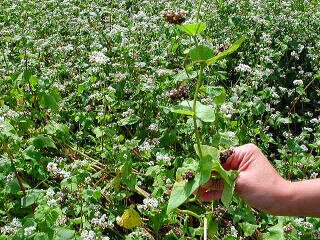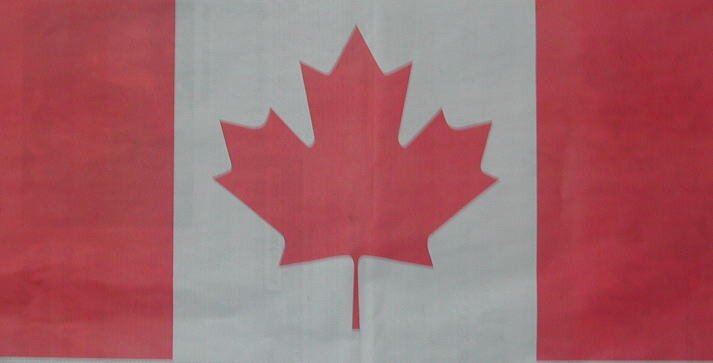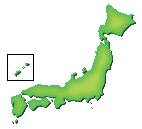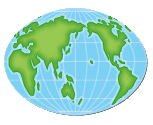 Soba Canada
Soba Canada
About Soba (Buckwheat)
(1) A word, "buckwheat"
(2) Common Buckwheat as a plant
(3) In Canada
(4) In Japan
(5) In the World
A word, the Buckwheat, originates in Anglo-Saxon. ie, "Boc and Whoet" (Beech and Wheat). Because a shape of the Buckwheat
fruit is resembling to the beechnut and usages are also about the same
for wheat like bread making etc. And the Scots simplified it to current
english word of "Buckwheat". But scientifically speaking Buckwheat
despite of its name does not belong to the wheat family. In China and Japan,
Buckwheat is also named as a wheat family. It is interesting to note that
both in East and West regardless of people, same naming was given to this
grain. What the human being feels and thinks is the same anywhere .
Fagopyrum Esculentum M. is the scientific name of common buckwheat we normally eat. The place of origin of Buckwheat is said to be Yunnan, China. An oldest
documentary records in China about 1500 years ago already had some article
on Buckwheat. In the medieval period, Buckwheat was introduced to Europe
through The Silk Road by people of the Saracen Empire. Thus in French the
buckwheat got a name of "Sarrasin". Then at beginning of 17th
century Buckwheat was brought into the New World by the Pilgrim Fathers
on board the "Mayflower".
Different from other grains like wheat, rice or corn etc, buckwheat is relying on insects (bees) or wind for pollination. If you go to the buckwheat field at the time of blooming, you will smell the flower's scent which is intended to induce bees to the flowers for pollination. Bees work just after sunrise when flowers are ready with pollens and honey but they don't work in the rain or low temperature or strong wind... So it depends on the weather which is a handicap compared with wheat/rice's self-pollination.
After sowing the seed buckwheat will normally germinate on 3rd day with
about 25 Degree C condition. In 3 days later a leave is coming out and
with another 2 weeks buds come....and start blooming flowers and can make
harvesting with 75 days after sowing. It's very fast, isn' it? But it is
also a fact that only less than 10% of bloomed flowers can have a full
fructification. It's a severe rule of the nature. Infinite inflorescence
and prone to lodging and easy seeds falling are also their wisdom to leave
as many genes as possible to the future though inconvenient to the human.
It grows well in cooler climate while hot with sun shine in day time but
cool down in the night. Normally the area with isotherm in June is low
as 17 DC fits for growing and doesn't choose type of soils also very rare
to suffer the damages caused by diseases and harmful insects. Buckwheat
is tough and strong as above and one more good thing is its Allelopathy.
Phytochemicals from the roots of buckwheat restrain germination and growing
of weeds together with fast growing leaves of buckwheat which cover the
earth and prevent photosynthesis of other weeds. Thus buckwheat field is
very clean without having weeds and can be used as a natural weeds killer
alternative especially for fallow field.
Common Buckwheat is an annual plant characterized with its heart-shaped leaves and fruits
are pyramid-shaped on axillary with densely clustered white flowers. It
is the tall erect plant with 70-150cm in height and produce several branches
but very prone to lodging due to hollow stem and shallow root system. In
Central/Western Canada, the seeding ranges between last week of May and
15th of June avoiding the risk of last spring frost and early autumn frost
as Buckwheat is very susceptible to the frost.
Buckwheat is not commercially important as wheat or rice but it brings
us surprising health benefits because of its superior nutritious aspects
as one of the best balanced functional foods. Recently as the study of
many scientists revealed well balanced nutritional structure of Buckwheat
with high Protein, Vitamins, Minerals, Fibres and Polyphenols such as Rutin
for adjusting various body functions which is reported to effectively lowers
blood pressure and cleans cholesterol and prevents and cures most adult's
diseases such as Cancer, Cardio Vascular diseases and blood related diseases
or type-2 Diabetes so on. The study now undergoing is opening a new window
for man-buckwheat interface which also is stimulating the demand for expansion
of this excellent grain. It could be said though Buckwheat is traditional
food but also is futuristic healthy food too.
![]() Return to the top of this page
Return to the top of this page
In Canada, Manitoba has been called "Buckwheat Capital of Canada" and
produced about 80% of domestic production followed by  Quebec and Ontario each about bit more than 10%. There were also small
production in Saskatchewan and Alberta. About 2/3 of the crop was exported
mainly to Japan and some goes to USA and Europe too.
Quebec and Ontario each about bit more than 10%. There were also small
production in Saskatchewan and Alberta. About 2/3 of the crop was exported
mainly to Japan and some goes to USA and Europe too.
My gracious! Local comsumption is sadly small despite of its miracle power.
This is a problem. It is important to let Canadians know the Buckwheat's
surprising possibilities to the health. Alas! again. Canadians don't have
Buckwheat restaurants to enjoy neither supermarket to buy. Sorry. But don't
worry hereafter you can come to us for eating and buying.
According to the UN/Governments, "Smoking" was defined as an epidemic of 20th century. Now they say "Obesity" is the epidemic of 21st century.
WHO (World Health Organization) defines the obesity by BMI (Body Mass Index) which to be culculated body weight (in kgs) devided by square of height
(in meter). If BMI is equal or higher than 25 is defined as Overweight
and over 30 is Obesity and normal is 18.5-24.99. According to its 2009
report, adult BMI of USA are 28.5 for men, 28.4 for women, Canada 27.5/26.8,
Japan 23.5/21.9. That means majority people are obese or overweighted in
USA and Canada, which could be applied to the most northern hemisphere
counyries except Japan.
In Europe 2006, WHO European Ministerial Conference on Counteracting Obesity
was held at Istanbul and declared "European Charter on counteracting
obesity" which member countries agreed to their obligation to tackle
to this issue as their first priority policy. What would be the cause of
this problem? Someone may simply say it's because of their DNA set in the
races. It could be said so but more realistically I think it is a matter
of the "life style". Cancer, diabetes, heart and blood related
diseases etc are said to be "Adult diseases" or "Life Style
diseases". Proper exercise , proper diet and proper way of living
could prevent or even cure these diseases. It is very important to review
our way of life and change it accordingly. However the difficulty for such
change is to require the change of the principles for the life. Especially
eat small, eat healthy is the key. Global population is now over 7 billions
and forecasted to be more than 9 billions by 2050 despite of of some study
warning earth's carrying capacity is 7 billions. Food Crisis is an imminent
danger. But who do care for such thing? While more than 50% of food supply
in northern hemisphere ended up in gabage dump and creating stupid environmental
pollution also loosing the chance to conquer starvation at needed area
of the world. You can be healthy and raise QOL by eating small. We have
to be serious and courageous for the principle change.
Buckwheat could be the symbolic tool for the change and we see the possible
solution to this epidemic.
Grain Commission establishes grades for buckwheat among other grains. It classifies in 3 grades checking the degree of soundness, damages such as dehulled or immature and foreign materials like cereal grains, ergot, stones etc. So we will carefully choose only "Canada No.1 Grade" for my business to serve you the best quality. There are many varieties of Buckwheat which Canada deserves to be proud of. As one of the most advanced country in Buckwheat study, Agriculture Canada thereafter succeeded by Kade Research Ltd, Morden Manitoba, developed many varieties but regrettably this company has stopped all activity in 2008 and said to be under legal dissolution process and no one is succeeding the buckwheat research in Canada now.
First variety was "Tokyo" which parent seeds were said to be
brought from Japan, "Tempest", "Manor" were short lived,
then came famous "Mancan" followed by "Manor", "Manisoba"
etc.. Latest varieties were "Koban" and "Koto" which
improved greatly the yeilding and quality. In 2005 epoch-making self-pollinated
new variety "Koma" was released for the first time in the world
and it dramatically changed the agricultural scenery and gave a strong/
positive impact to the industry but it was the end of Kade activity. However
Koma is good in colour, aroma and flavour and also workability at the time
of making soba is excellent. Currently in China , they mainly grow "Mancan"
which was named taking initials of Manitoba and Canada and in US they grow subsequent Kade varieties. So it would not be
an overstatement to say that Canada was the king of the world buckwheat
industry and sincerely hope to see Canada's revival in this industry in
short future.
North American Buckwheat Promotional Committee
In December 2001, buckwheat related people from governments/private organizations
mainly in Manitoba gathered together and formed this committee in order
to develop and promote expanded use of buckwheat and its products by creating
awareness of buckwheat's natural nutritional advantages and started acting
as a technical advisory committee to the Canadian Special Crops Association.
The committee quickly realized consumer demand for foods with health benefits,
along with the increased interest in functional foods and pharmaceauticals,
there was a need to educate consumers about the health benefits and nutritional
attributes of buckwheat. A strategy was developed to educate health professionals
(dietitians, food and nutrition professionals) of the nutritional attributes
of buckwheat, who in turn would educate the public. Slow but steady would
win the race was an idea. But as the collapse of the Kade, buckwheat industry
in Canada also practically faded out and so for this Promotional Committee
too.
Nevertheless we still have a hope for the revival of the industry and endeavouring
for building up something new.
![]() Return to the top of this page
Return to the top of this page
In Japan, the first record on Buckwheat appeared about 1300 years ago. It was the
Nara Era and Empress Gensho encouraged the  people to cultivate more buckwheat and wheat preparing for the famine.
But it was only about 400 years ago in Edo Era (Tokugawa Shogun Era) when
Soba in noodle style of eating was establishsed firmly. This was supported
by the diffusion of the water mill and stone mill in both rural and urban
areas. By that time granular style was common way of eating. Soba in noodle
style was the food for the celebration or for gala occasion and felt something
special. For example, at the time of moving to the new place of living,
Japanese still buy Soba to their new neighbours (Hikkoshi Soba). Or at
the New Year's Eve, we eat soba wishing for prosperous new year and longevity.
Nowadays Soba establishes its reputation as one of the most sophisticated
and refined foods in Japan backed up by the tradition and especially by
stylish Edokko culture. Edokko can be defined as the people who lived in
Edo (ancient name of Tokyo) for more than three generations and were very
generous for spending everything in one night but with plenty of guts.
To tell you the truth, I am also a semi-Edokko born in a heart of Edo,
Asakusa, and grown up there but only with 2 generations. Amongst many Soba
styles, I will serve my Soba in line with the main stream of Edo Style
which is the most advanced and refined style technically and also in quality
and presentation.
people to cultivate more buckwheat and wheat preparing for the famine.
But it was only about 400 years ago in Edo Era (Tokugawa Shogun Era) when
Soba in noodle style of eating was establishsed firmly. This was supported
by the diffusion of the water mill and stone mill in both rural and urban
areas. By that time granular style was common way of eating. Soba in noodle
style was the food for the celebration or for gala occasion and felt something
special. For example, at the time of moving to the new place of living,
Japanese still buy Soba to their new neighbours (Hikkoshi Soba). Or at
the New Year's Eve, we eat soba wishing for prosperous new year and longevity.
Nowadays Soba establishes its reputation as one of the most sophisticated
and refined foods in Japan backed up by the tradition and especially by
stylish Edokko culture. Edokko can be defined as the people who lived in
Edo (ancient name of Tokyo) for more than three generations and were very
generous for spending everything in one night but with plenty of guts.
To tell you the truth, I am also a semi-Edokko born in a heart of Edo,
Asakusa, and grown up there but only with 2 generations. Amongst many Soba
styles, I will serve my Soba in line with the main stream of Edo Style
which is the most advanced and refined style technically and also in quality
and presentation.
Japan has been consuming about 125,000K/T* of buckwheat per year but domestic
production is only about 25,000K/T leaving self-sustenance ratio of only
20% of the total consumption. So once Japan was the largest customer for
Canadian Buckwheat but also severest demanding country in quality of the
crop only buying No. 1 Grade of the new crops which could give desired
flavour and aroma to its Soba. Canadian export to Japan in 5 years average
ending year 2000 was about 6,700K/T. But we saw the declining tendency
as China has eaten up Canadian share. (in 2007 Canadian export collapsed
practically to zero due to a trouble in the international consortium. But
in 2009 an endeavour to regain the lost market share has started and was
expected to have a success shortly.) Why did Canada loose its share in
the market? Of course main reason was Japanese dommestic market situation
based upon agricultural subsidy of the government but as majority Canadian
industry people explained that China had a geographical advantage together
with its lower labour costs but it's just a small part of the whole story
or more straight forwardly we dare to say that very such kind of excuse
must have destroyed the once successful trade. We do feel that Canadian
exporters' endeavour to sell their marchandise was somewhat unfocused and
a lot of thing should be studied seriously in order to have a success again
in the aimed market.
| @Year | Japan Domestic | Canada | USA | China | Aust | Othes | Supply Total | GroatsiWhole Buckheat equivalent j |
Total Supply ( Whole Buckwheat Equivalent) |
| 1996 | 24,000 21.2 |
4,609 4.1 |
12,974 11.5 |
79,400 62.3 |
919 0.8% |
169 0.1 |
113,071 100 |
||
| 1997 | 21,877 17.3 |
9,635 7.6 |
7,187 5.7 |
86,916 68.7 |
908 0.7 |
1 0.0 |
126,524 100 |
||
| 1998 | 17,900 15.3 |
7,714 6.6 |
8,466 7.2 |
82,098 70.0 |
985 0.8% |
96 0.1 |
117,259 100 |
||
| 1999 | 24,023 18.9 |
5,445 4.3 |
8,193 6.4 |
87,813 69.0 |
1,561 1.2 |
332 0.3 |
127,313 100 |
||
| 2000 | 29,200 23.1 |
5,969 4.7 |
7,922 6.3 |
81,848 64.8 |
834 0.7 |
477 0.4 |
125,250 100 |
||
| 5 years average | 23,400 19.2 |
6,674 5.5 |
8,938 7.3 |
81,815 67.0 |
1,041 0.9 |
215 0.2 |
122,083 100.0 |
||
| 5 years average share | ° | 6.8 | 9.1 | 82.9 | 1.1 | 0.2 | Import100 | ||
| 2001 | 25,400 21.5% |
4,148 3.5% |
4,675 4.0% |
82,460 69.8% |
856 0.7% |
583 0.5% |
118,122 100% |
||
| 2002 | 29,000 24.7 |
3,600 3.1 |
5,600 4.8 |
80,000 68.1 |
1,100 0.9 |
250 0.2 |
117,550K/T 100 |
||
| 2003 | 28,100 23.4% |
3,035 2.5% |
7,048 5.9% |
80,800 67.3% |
677 0.6% |
400 0.3% |
120,060 100% |
||
| 2004 | 20,400 18.6% |
1,969 1.8% |
7,578 6.9% |
78,730 71.6% |
831 0.8% |
437 0.4% |
109,945 100% |
||
| 2005 | 31,800 27.2% |
1,417 1.2% |
10,432 8.9% |
71,703 61.4% |
1,136 1.0% |
231 0.2% |
116,719 100% |
||
| 5 year average |
26,940 23.0% |
2,834 2.4% |
7,103 6.1% |
78,739 67.3% |
920 0.8% |
380 0.3% |
116,916 100% |
||
| 5 year average share | - | 3.1% | 7.9% | 87.5% | 1.0% | 0.4% | Import100 | ||
| 2006 | 33,000 29.6% |
1,474 1.3% |
11,196 10.1% |
63,363 56.9% |
732 0.7% |
1,567 1.4% |
111,332 100% |
||
| 2007 | 26,300 27.0% |
2,580 2.7% |
11,976 12.3% |
55,974 57.6% |
278 0.3% |
126 1.3% |
97,234 100% |
29,563 (45,481) |
142,715 |
| 2008 | 23,200 26.9% |
2,186 2.5% |
14,013 16.3% |
46,369 53.8% |
137 0.2% |
237 0.3% |
86,142 100% |
29,129 (44,813) |
130,955 |
| 2009 | 15,300 20.4% |
337 0.4% |
15,219 20.3% |
43,654 58.2% |
223 0.3% |
216 0.3% |
74,949 100% |
31,234 (48,052) |
123,001 |
| 2010 | 29,700 29.7% |
193 0.2% |
16,870 16.9% |
51,788 51.8% |
799 0.8% |
615 0.6% |
99,965 100% |
29,416 (45,255) |
145,220 |
| 5 year average | 25,500 27.1% |
1,354 1.4% |
13,855 14.8% |
52,230 55.6% |
434 0.5% |
552 0.6% |
93,924 100% |
||
| 5year average share | - | 2.0% | 20.2% | 76.3% | 0.6% | 0.8% | Import100 | ||
| 2011 | 32,000 36.1% |
725 0.8% |
18,381 0.21% |
35,644 0.40% |
882 1.0% |
893 1.0% |
88,525 100% |
31,747 (48,841) |
137,366 |
| 2012 | 44,000 44.9% |
978 1.0% |
16,792 17.1% |
35,238 35.9% |
137 0.1% |
932 1.0% |
98,077 100% |
38,750 (59,615) |
157,692 |
| 2013 | 33,100 44.5% |
35 0.0% |
14,426 19.4% |
26,047 35.0% |
48 0.1% |
778 1.0% |
74,434 100% |
36,256 (55,778) |
130,212 |
| Japan Domestic | Canada | USA | China | Aust | Others | Supply TTL | Groats | Whole buckwheat Equivalent |
![]() Return to the top of this page
Return to the top of this page
In the world; According to FAO statistics, world buckwheat harvest in 5
years average from 2000 to 2004 was reported to be 2.71 Million K/T. The
biggest producer is China followed by Russia. Russia combined with Eastern
Europeans shares about 40% of world production. By these two groups about
91% of the world production is covered.
According to FAO statistics, world buckwheat harvest in 5
years average from 2000 to 2004 was reported to be 2.71 Million K/T. The
biggest producer is China followed by Russia. Russia combined with Eastern
Europeans shares about 40% of world production. By these two groups about
91% of the world production is covered.
Next 5 years world harvest average (2009-2013) is about 2.07 million tonnes
which is about 24%
decline from previous 5 years average. Though it is only an estimate, China's
past 5 years average was 1.40 million tonnes but it also declined to 0.64
million tonnes which shows 54% sharp decline. This tendency would be accelerated
further considering china's overall situation and the harvest in 2014 is
estimated only 85thousand tonnes which could merely cover their own demands
by drastic decrease of the acreage aiming for more lucrative crops.
Quantity of world production is staying low because of a bad weather and
changing to grow more lucrative crops such as beans or corns etc.
![]() Return to Index Page
Return to Index Page ![]() Return to the top of this page
Return to the top of this page
San-tate Policy & Our Business, Soba & Health/Safety of Foods, Japan Nowadays, Various Recipes of Buckwheat, Contact Us, Links to other sites